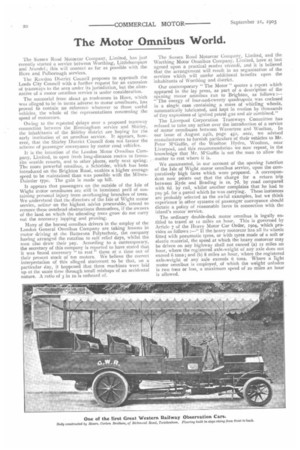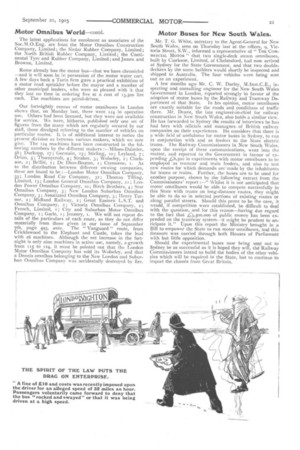The Motor Omnibus World.
Page 4

Page 5

If you've noticed an error in this article please click here to report it so we can fix it.
The Sussex Road Motorcar Company, Limited, has just recently started a service between Worthing, Littlehampton and Arundel; this will connect as far as possible with the Hove and Pulborough services,
1 he Rawdon District Council proposes to approach the Leeds City Council with a further request for an extension of tramways to the area under its jurisdiction, but the alternative of a motor omnibus service is under consideration.
The memorial from about 40 tradesmen in Hove, which was alleged to be in terms adverse to motor omnibuses, has proved to contain no reference whatever to those useful vehicles, the whole of the representations concerning the speed of motorcars.
Owing to the repeated delays over a proposed tramway connection between the Birmingham service and Shirley, the inhabitants of the Shirley district are hoping for the early institution of an omnibus service. It appears, however, that the Shirley District Council does not favour the scheme of passenger conveyance by motor road vehicles.
It is the intention of the London Motor Omnibus Company, Limited, to open fresh long-distance routes to favourite seaside resorts, and to other places, early next spring. The more powerful omnibus, a Schiebler, which has been introduced on the Brighton Road, enables a higher average speed to be maintained than was possible with the MilnesDaimler type, The gain is made up hill.
It appears that passengers on the outside of the Isle of Wight motor omnibuses are still in imminent peril of sustaining personal injury trom overhanging branches of trees. We understand that the directors of the Isle of Wight motor service, actinre on the highest advice procurable, intend to remove these overhead obstructions themselves, if the owners of the land on which the offending trees grow do not carry out the necessary lopping and pruning.
Many of the horsed omnibus drivers in the employ of the London General Omnibus Company are taking lessons in motor driving at the Battersea Polytechnic, the company having arranged the rotation to suit relief days, whilst the men also draw their pay. According to a contemporary, the secretary of this company is reported to have stated that it was found. necessary " to rest " three at a time out of their present stock of ten motors. We believe the correct interpretation of this alleged statement to be that, on a particular day, it happened that three machines were laid up at the same time through small mishaps of an accidental nature. A ratio of 3 in to is unheard of.
The Sussex Road Motorcar Company, Limited, and the WorthingMotor Omnibus Company, Limited, have at last agreed upon a practical 'modes vivendi, and it is believed that the arrangement will result in an organisation of the services which will confer additional benefits upon the inhabitants of Worthing and district.
Our conteniporary "The Motor" quotes a report which appeared in the lay press, as part of a description of the opening motor omnibus run to Brighton, as follows :— " The energy of four-and-twenty quadrupeds was enclosed in a single case containing a mass of whirling wheels, automatically lubricated, and kept in motion by thousands of tiny explosions of ignited petrol gas and air combined."
The Liverpool Corporation Tramways Committee has refused to take any action over the introduction of a service of motor omnibuses between Wavertree and Woolton. In our issue of August 24th, page 452, ante, we advised manufacturers to furnish particulars of their vehicles to Mr. Peter M`Guffie, of the Wootton Hydro, Wootton, near I.iverpool, and this recommendation we now repeat, in the knowledge that Mr. M‘Guffie is not the man to allow the matter to rest where it is.
We commented, in our account of the opening function of the Isle of Wight motor omnibus service, upon the comparatively high fares which were proposed. A correspondent now points out that the charge for a return trip between Ryde and Brading is Is. 7d. by road compared with 6d. by rail, whilst another complains that he had to pay 3d. for a parcel which he was carrying. These instances are probably selected as the awful examples, but we think experience in other systems of passenger conveyance should dictate a policy of reasonable fares in connection with the island's motor service.
The ordinary double-deck motor omnibus is legally entitled to travel at 12 miles an hour. This is governed by Article 7 of the Heavy Motor Car Order, 1904, which provides as follows :—" If the heavy motorcar has all its wheels fitted with pneumatic tyres, or with tyres made of a soft or elastic material, the speed at which the heavy motorcar may be driven on any highway shall not exceed (a) ta miles an hour, where the registered axle-weight of any axle does not exceed 6 tons ; and (b) 8 miles an hour, where the registered axle-weight of any axle exceeds 6 tons. Where a light motor omnibus is employed, of which the weiFht unladen is two tons or less, a maximum speed of 20 miles an hour is allowed.
The latest applications for enrolment as associates of the Soc.M.O.Eng. are from the Motor Omnibus Construction Company, Limited; the Sirdar Rubber Company, Limited; the North British Rubber Company, Limited; the Continental Tyre and Rubber Company, Limited; and James and Browne, Limited.
Rome already has the motor bus—that we have chronicled —and it will soon be in possession of the motor water cart. A few days back a Turin firm gave a practical exhibition of a motor road sprinkler before the mayor and a number of other municipal leaders, who were so pleased with it that they lost no time in ordering five at a cost of 13,500 lire each. The machines are petrol-driven.
Our fortnightly census of motor omnibuses in London shows that, on Monday last, there were 124 in operative use. Others had been licensed, but they were not available for service. We have, hitherto, published only one set of figures from the many which are regularly secured by our staff, those divulged referring to the number of vehicles on particular routes. It is of additional interest to notice the present division as between various makers, which we now give. The y24 machines have been constructed in the following numbers by the different makers :—Milnes-Daimler, 58; Durkopp, 17; Germain, 13 ; Stirling, 10; Leyland, 7; Orion, 5; Thornycroft, 4; Straker, 3; Wolseley, 2; Clarkson, 2; Brillie, ; De Dion-Bouton, ; Cremorne, 1. As to the distribution between different owning companies, these are found to be :—London Motor Omnibus Company, 33; London Road Car Company, 32; Thomas Tilling, Limited, y3; London General Omnibus Company, 11; London Power Omnibus Company, to; Birch Brothers, 4 ; Star Omnibus Company, 3 ; New London Suburban Omnibus Company, 3 ; Associated Omnibus Company, 3 ; Henry Turner, 2; Midland Railway, 2; Great Eastern L.S.T. and Omnibus Company, 2; Victoria Omnibus Company, 2 ; French, Limited, 1; City and Suburban Motor Omnibus Company, 1; Garle, 1; Jennery, 1. We will not repeat details of the particulars of each route, as they do not differ materially from those given in our issue of September 7th, page 493, ante. The " Vanguard " route, from Cricklewood to the Elephant and Castle, takes the lead with 26 machines. Although the net increase in the fortnight is only nine machines in active use, namely, a growth from 115 to 124, it must be pointed out that the London Motor Omnibus Company has sold its Wolseley, and that a Dennis omnibus belonging to the New London and Suburban Omnibus Company was accidentally destroyed by fire. Motor Buses for New South Wales.
Mr. T. G. White, secretary to the Agent-General for New South Wales, seen on Thursday last at the offices, 9, Victoria Street, S.W., informed a representative of "THE Costmi.:aceke MOTOR" that two single-deck steam omnibuses, built by Ciarkson, Limited, of Chelmsford, had now arrived at Sydney for the State Government, and that two doubledeckers by the same builders would shortly be inspected and shipped to Australia. The four vehicles were being sent out as an experiment. A few months ago Mr. C. W. Darley, M.lnst.C.E. inspecting and consulting engineer for the New South Wales Government in London, reported strongly in favour of the adoption of motor buses by the Railway and Tramway Department of that State. In his opinion, motor omnibuses are exactly suitable for the roads and conditions of traffic there. Mr. Deane, the late engineer-in-chief for railway construction in New South Wales, also holds a similar view. He has forwarded to Sydney the results of interviews he has had here with officials and managersof British railway companies on their experiences. He considers that there is a wide field of usefulness for motor buses in Sydney, to run in conjunction with and as feeders to the State electric trams. 'the Railway Commissioners in New South Wales, upon the receipt of these communications, went into the matter, and reported to the Governthent in favour of expending -„C,8,5oo in experiments with motor omnibuses to be employed as tramcar and train feeders, and also to test new routes for which demands are-made by the inhabitants for trams or trains. Further, the buses are to be used for another purpose, shown by the following extract from the Commissioners' report :—" Whilst it is not anticipated that motor omnibuses would be able to compete successfully in this State with trams on long-distance routes, they might be able to do so in selected portions of existing routes or along parallel streets. Should this prove to be the case, it would, if competition were established, be difficult to deal with the question, and for this reason—having due regard to the fact that £3,500,000 of public money has been expended on the tramway system—it might be prudent to anticipate it." Upon this report the Ministry brought in a Bill to empower the State to run motor omnibuses, and this measure was carried through both Houses of Parliament with but little opposition.
Should the experimental buses now being sent out to Sydney be as successful as it is hoped they will, the Railway Commissioners intend to build the bodies of the other vehicles which will be required. in the State, but to continue to import the chassis from Great Britain.
















